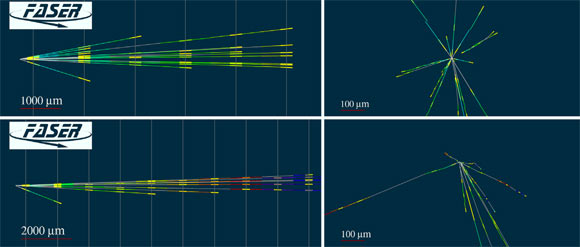CERN Physicists Detect Collider Neutrinos for First Time
Nov 26, 2021 by News Staff / Source
Physicists from the Forward Search Experiment (FASER) Collaboration have observed six neutrino interactions during a pilot run of FASERν, a compact emulsion detector installed at CERN’s Large Hadron Collider (LHC) in 2018.

FASERν event displays of two of the neutral vertices in the yz projection longitudinal to the beam direction (left) and in the view transverse to the beam direction (right). Image credit: FASER Collaboration.
“Prior to this project, no sign of neutrinos has ever been seen at a particle collider,” said Professor Jonathan Feng, a reseacher in the Department of Physics and Astronomy at the University of California, Irvine, and co-leader of the FASER Collaboration.
“This significant breakthrough is a step toward developing a deeper understanding of these elusive particles and the role they play in the Universe.”
The FASERν instrument was made up of lead and tungsten plates alternated with layers of emulsion.
During particle collisions at the LHC, some of the neutrinos produced smash into nuclei in the dense metals, creating particles that travel through the emulsion layers and create marks that are visible following processing.
These etchings provide clues about the energies of the particles, their flavors — tau, muon or electron — and whether they’re neutrinos or antineutrinos.
“The emulsion operates in a fashion similar to photography in the pre-digital camera era,” Dr. Feng said.
“When 35-mm film is exposed to light, photons leave tracks that are revealed as patterns when the film is developed.”
The FASER physicists were likewise able to see neutrino interactions after removing and developing the detector’s emulsion layers.
“Having verified the effectiveness of the emulsion detector approach for observing the interactions of neutrinos produced at a particle collider, we’re now preparing a new series of experiments with a full instrument that’s much larger and significantly more sensitive,” Dr. Feng said.
“Given the power of our new detector and its prime location at CERN, we expect to be able to record more than 10,000 neutrino interactions in the next run of the LHC, beginning in 2022,” said Dr. David Casper, a researcher in the Department of Physics and Astronomy at the University of California, Irvine, and co-leader of the FASER project.
“We will detect the highest-energy neutrinos that have ever been produced from a human-made source.”
“What makes FASERν unique is that while other experiments have been able to distinguish between one or two kinds of neutrinos, it will be able to observe all three flavors plus their antineutrino counterparts.”
“There have only been about 10 observations of tau neutrinos in all of human history but that we expect our team will be able to double or triple that number over the next three years.”
The results were published in the journal Physical Review D.
_____
Henso Abreu et al. (FASER Collaboration). 2021. First neutrino interaction candidates at the LHC. Phys. Rev. D 104 (9): L091101; doi: 10.1103/PhysRevD.104.L091101
http://www.sci-news.com/physics/cern-collider-neutrinos-10311.html?utm_source=feedburner&utm_medium=email
Thanks to: http://www.sci-news.com
Related posts:
Views: 0
 RSS Feed
RSS Feed

















 November 28th, 2021
November 28th, 2021  Awake Goy
Awake Goy 





 Posted in
Posted in  Tags:
Tags: 
















